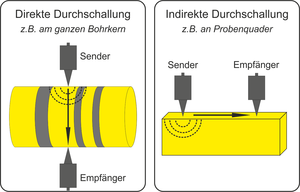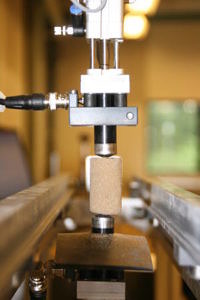Ultrasound Logger
 Ultrasound logger
Ultrasound logger
The petrophysics laboratory of the Chait of Geology has an ultrasound measuring system that enables the examination of whole drill cores as well as individual rock samples with regard to their sound transit time.
 Here, both longitudinal and shear wave velocities can be measured on cores up to a resolution of 1mm. The fully automatically controlled device ensures fast and efficient measurement of contiguous drill core intervals.
Here, both longitudinal and shear wave velocities can be measured on cores up to a resolution of 1mm. The fully automatically controlled device ensures fast and efficient measurement of contiguous drill core intervals.
The piezoelectric probes allow use free of coupling agents, so your samples are protected from contamination. Direct transmission is usually used, with the ultrasonic transmitter and receiver facing each other. Indirect transmission is also possible. To guarantee consistent quality of your measurement results, the probes are operated at a constant contact pressure of 3 bar. Ultrasonic frequencies of 20, 46, 64, 80, 250 and 350 kHz can be set.
Areas of application:
The use of ultrasound technology is a proven method for damage mapping on historic buildings made of natural stone and is therefore particularly suitable for assessing the quality of natural building stones.
The sound travel time of the longitudinal wave can be used as a porosity proxy of rocks. The modulus of elasticity (E-modulus) of the rock to be examined can be determined via the ratio of the travel times of the shear wave to the longitudinal wave and thus its compressive strength can be estimated.
Likewise, the high-resolution documentation of the ultrasonic travel time of rocks provides meaningful information for stratigraphic questions or for the assessment and characterisation of geothermal or hydrocarbon reservoirs.
Sample geometries:
With longitudinal wave measurement, drill cores up to one metre long can be examined in one piece. These can be either whole (round) or halved. In the case of shear wave measurement, plane-parallel surfaces must be present on both sides (in the case of direct through-sounding). If indirect coupling is used, a halved drill core is sufficient. Single samples of cuboid, cube or cylinder shape are also possible.
The advantages in summary:
– High-resolution and precise determination of P- and S-wave velocities
– Proxies for rock porosity, compressive strength and quality
– Individually adjustable measuring distances
– Guaranteed consistent measurement quality
– No contamination of the sample by coupling agent
